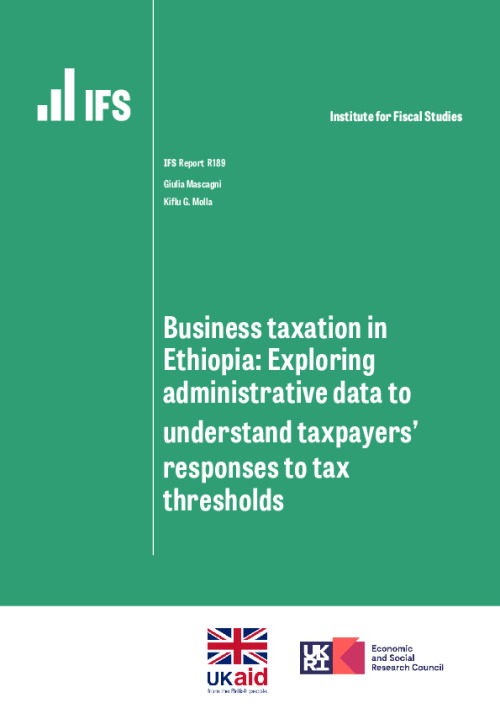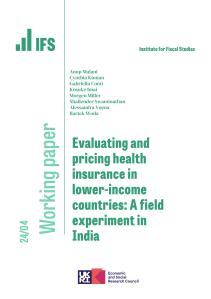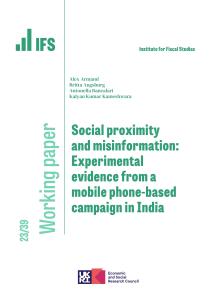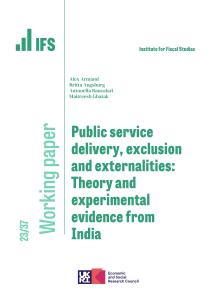Increasing tax revenues is a priority in low-income countries, where governments collect much less revenue as a share of GDP than in middle- or high-income countries - about 15% on average. In the context of small personal income tax bases, taxes paid and remitted by businesses frequently represent a large proportion of total tax revenues and are therefore an important source of financing for development.
Yet policymakers often know relatively little about how businesses respond to their tax systems, and their understanding of business behaviour is hindered by weak administrative capacity, and high levels of evasion and informality in the economy.
Against this backdrop, this report has two main objectives:
- To map the discontinuities in the Ethiopian business taxation system by documenting relevant tax laws and the practice of tax administration. We are particularly interested in the policy and administrative thresholds that determine, for example, changes in the marginal rates of taxation for firms, and whether firms should register for VAT or report to the Large Taxpayers’ Office (LTO). In a context where information about the tax system is not always readily available, compiling details about thresholds and the procedures around them represents a valuable contribution.
- To provide exploratory analysis of businesses’ responses to the tax system in Ethiopia using administrative data from tax returns. We do this by investigating whether some taxpayers respond to discontinuities in the tax system by strategically positioning themselves on one side of a threshold in order to minimise tax liabilities, reduce compliance costs, or to access certain tax instruments that may benefit them in other dimensions. This phenomenon is known as ’bunching’ in the academic literature. This analysis is the first using administrative data in Ethiopia and is largely exploratory and descriptive, representing a starting point for further research.
Key findings
- There is no evidence that an excessively large number of businesses in Ethiopia report a profit equal to, or just below, the level at which marginal tax rates increase in the business income tax schedule. This is contrary to the evidence in middle- and high-income countries. Although crossing these thresholds would imply higher marginal tax rates for sole proprietors, the rate increases in the graduated schedule are small relative to those analysed in other countries, which may help to explain this lack of response.
- There is some weak evidence that a disproportionately large number of sole proprietors report a turnover just above the 500,000 Birr (25,528 USD in 2014) turnover threshold. Crossing this threshold has two key implications for businesses: they must submit more detailed financial records to the revenue authority, and they must register for VAT. It is not straightforward to explain this finding, and weaknesses in the available data, as well as the somewhat inconsistent behaviour of other types of taxpayers around this threshold complicate our interpretation of this result. Although it seems plausible that the VAT registration threshold could be driving this response, the evidence is not conclusive. In Ethiopia VAT-registered firms enjoy a number of benefits: First, they can compete for government procurement contracts. Second, they can trade with other VAT-registered firms, and access a larger number of customers. These benefits combined may outweigh the additional costs associated with complying with the VAT, submitting more information to the revenue authority, and the slightly higher effective tax rates that businesses pay. It is important to note, however, that firms registered for the simplified turnover tax (ToT) also demonstrate some slight bunching behaviour above this threshold, while corporations, which should face similar incentives in terms of accessing the VAT system, do not.
- Businesses in Ethiopia do not appear to respond to administrative thresholds which segment them according to their size. This is in spite of potentially higher reporting and compliance costs and more intensive enforcement activities targeted at businesses with larger turnovers. The lack of response is likely linked to the fact that taxpayers are unaware of the change in location of these thresholds in advance and cannot manipulate their reported turnovers meaningfully as a result. In theory, businesses might prefer to avoid being subject to the additional compliance costs and enforcement efforts associated with reporting at the Large Taxpayers’ Office (LTO), for example. In practice, ambiguous local incentives and limited information about the location of the threshold mean that a priori, there should not be any bunching present.
This preliminary analysis of available administrative data, therefore, finds very limited evidence of responses by Ethiopian taxpayers to discontinuities in the tax system. The lack of response to the income tax kinks and the LTO administrative notch is not entirely surprising given the scale of policy changes and 'fuzziness' of the administrative thresholds. The slight bunching above the 500,000 Birr turnover threshold by sole proprietors is puzzling, although could potentially be rationalised by the access to public procurement bids. But overall, the complexity and fuzziness of the changes at this threshold make understanding the incentives faced by taxpayers and interpreting our empirical findings difficult.
The use of administrative tax data in the preparation of this report has highlighted the importance of generating and maintaining better digitised records for all taxpayers, tax offices, and across tax types. This would enable the revenue authority to develop a more in-depth understanding of its taxpayers, more effectively administer its tax system, and would support more nuanced policy-relevant research. For example, data limitations mean that in this analysis the turnover data used to explore taxpayers’ responses to the VAT registration threshold derives from the income tax returns, as opposed to the VAT and ToT returns, because of the lack of data from the ToT declarations. Moreover, data entry into the Standard Integrated Government Tax Administration System (SIGTAS) is not uniform and in some areas of Ethiopia, information is only entered for certain taxpayers, with the criteria for entry largely unclear. This results in uneven coverage of taxpayers in the data outside of Addis Ababa, especially for unincorporated firms. As a result, the findings should be interpreted cautiously. It would be useful to further investigate taxpayers’ responses around the 500,000 Birr turnover threshold using additional ToT returns data for the universe of firms in Ethiopia to ensure that the findings are robust.











